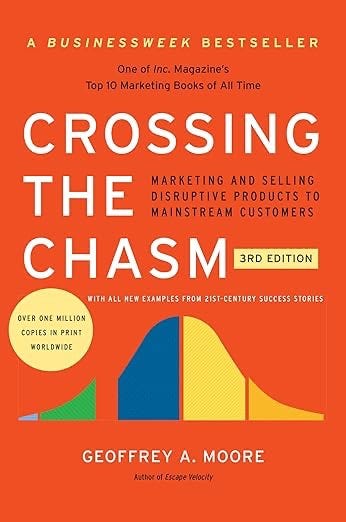Author Geoffrey Moore makes the case that high-tech products require marketing strategies that differ from those in other industries. His chasm theory describes how high-tech products initially sell well, mainly to a technically literate customer base, but then hit a lull as marketing professionals try to cross the chasm to mainstream buyers. This pattern, says Moore, is unique to the high-tech industry.
Moore suggests remedies for the problem that can help businesses meet their long-term goals. He coaches marketing professionals on how to move slowly through the gulf, teaching them to create profiles and target specific segments of the population rather than trying to plow right into the mainstream. He cites examples of successful chasm crossings by such companies as Apple, Tandem, Oracle, and Sun, showing what they all had in common and exposing the different weaknesses in their strategies. Moore also assigns responsibility for success to programmers and developers by suggesting they design a "whole product model." Here, because integration tasks are daunting to the mainstream market, all the components of a technological product must be in one package. Moore also describes strategies for competing with rival companies and assessing the best distribution channels for penetrating the target market.
Written not just for marketing specialists but for all employees whose futures ride on the success of a technical product, Crossing the Chasm delivers crucial information in an engaging, readable tone.
Key Lessons from Crossing the Chasm by Geoffrey Moore:
The Chasm Represents a Critical Gap: The transition from early adopters to the mainstream market is a significant hurdle for disruptive products. Early adopters embrace innovation for its novelty, but mainstream customers demand proven, reliable solutions.
Target a Niche Market First: To cross the chasm, focus on a specific segment of the mainstream market (a “beachhead”) where your product solves a pressing problem. Build a strong foothold before expanding to adjacent markets.
Create a Whole Product Solution:Mainstream customers expect a complete solution, not just a product. This means providing everything needed for the product to deliver its promised value, including support, services, and integrations.
Positioning is Key: Establish clear positioning that communicates how your product solves the specific needs of your target market. Differentiate yourself from competitors and emphasize tangible benefits to gain trust and credibility.
Leverage the Technology Adoption Life Cycle: Understand the distinct needs and behaviors of each customer group (innovators, early adopters, early majority, late majority, and laggards). Tailor your marketing and sales strategies to address these differences effectively.











